Scarsdale Police Capture Eastchester Burglars
- Details
- Hits: 5976
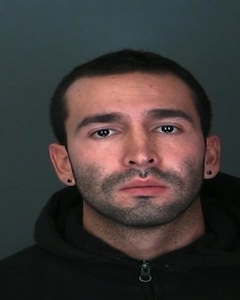 A rapid response by Scarsdale Police officers on Friday evening 2/22 resulted in the arrest of three fleeing burglary suspects who had just robbed an Eastchester home. According to Scarsdale Lieutenant Thomas Altizio, an off-duty Eastchester Police Officer, Richard Natoli, spotted a suspect leaving the backyard of an Eastchester home. When the man was questioned, he jumped into a car with two other men and drove north on Scarsdale Avenue. The driver of the escape car then made a left turn onto the Popham Road Bridge and was spotted by Scarsdale Police officers on traffic duty on the bridge. They notified headquarters that the getaway car had turned south on Garth Road. Scarsdale Police officers rushed to Garth Road and stopped the car containing the three men at Garth Road near Harney Road at 7:00 pm on Friday night. The men were taken into custody and held until they could be turned over to the Eastchester Police.
A rapid response by Scarsdale Police officers on Friday evening 2/22 resulted in the arrest of three fleeing burglary suspects who had just robbed an Eastchester home. According to Scarsdale Lieutenant Thomas Altizio, an off-duty Eastchester Police Officer, Richard Natoli, spotted a suspect leaving the backyard of an Eastchester home. When the man was questioned, he jumped into a car with two other men and drove north on Scarsdale Avenue. The driver of the escape car then made a left turn onto the Popham Road Bridge and was spotted by Scarsdale Police officers on traffic duty on the bridge. They notified headquarters that the getaway car had turned south on Garth Road. Scarsdale Police officers rushed to Garth Road and stopped the car containing the three men at Garth Road near Harney Road at 7:00 pm on Friday night. The men were taken into custody and held until they could be turned over to the Eastchester Police.
Stolen items from the home were found in the car.
The three men were identified as: Anderson B. Moncada, 24, of 39 Thomas St. in Brentwood; , 29, of 46-08 74th St. in Elmhurst; Juan D. Hernandez-Moncada and Fabian Idarraga, 29, of 21-22 30th St. in Astoria. They were charged with robbing two homes in Eastchester – one on Vernon Drive and the other on Hilburn Road, a second-degree burglary. They are now being held on $150,000 in Westchester County Jail.


Update on DAS in Scarsdale
- Details
- Hits: 4633
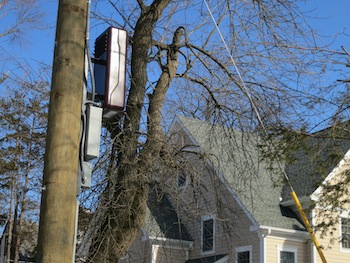 For those who are concerned about new DAS antennas in Scarsdale, here's the latest. Following a meeting of the Scarsdale Planning Board on February 11 to discuss changes to the zoning code to accommodate DAS in Scarsdale, residents saw new DAS antennas going up around town.
For those who are concerned about new DAS antennas in Scarsdale, here's the latest. Following a meeting of the Scarsdale Planning Board on February 11 to discuss changes to the zoning code to accommodate DAS in Scarsdale, residents saw new DAS antennas going up around town.
One was installed on Palmer Avenue and we also heard that several went up on the Post Road. Since these roads are state owned, the telecommunications company did not need Scarsdale's permission to install antennas in the right of way.
We called Village Planner Elizabeth Marrinan on February 18 to inquire about the antennas and she says that the Building Department will spend an inspector to look into who installed the antennas and confirm that they were authorized. This has not been done to date. We also emailed Peter Heimdehl of Crown Castle, the company that applied to install DAS antennas on residential streets in Scarsdale. He did not reply to our request for more information.
However, we did hear from public health advocate Deborah Kopald who is running a
Conference called "Corporate Interference with Science and Health" in NYC on March 13th and 14th. She has convened a group of experts to discuss food, fracking and wireless technologies. According to Kopald, "The wireless piece is the topic nobody knows about or is talking about- but it is a huge public health threat-especially in NYC, which is the least regulated environment in the world."
The panel will include an international expert on cell phone health effects; Lennart Hardell, MD, PhD from Sweden. Hardell's work was the basis for the World Health Organization's (WHO) declaration that radiofrequency radiation a class 2b carcinogen. The other experts speaking on this topic (which includes the transmitter infrastucture such as wi-fi, cell towers and "smart meters") are David O. Carpenter, MD from the Presidential Cancer Panel, Representative Andrea Boland (Maine), Toxicologist Magda Havas, PhD, Deborah Kopald and former US Attorney Whitney North Seymour, Jr.
Kopald says that "New York City is one of the only places in the world with no regulations on cell transmitters where they pop up outside peoples' bedroom windows and on the decks of fancy penthouses and are a major public health problem, along with Wi-Fi ... a concept that I realize is anathema to almost everybody!"
She believes that the risk has not been adequately covered by the media and contends that reputable scientists say that if you look at non-industry sponsored research, radio frequency radiation looks to be a worse health threat than global warming.
Panelists at the meeting include:
- Will Allen, PhD
- Ronald E. Bishop, PhD, CHO
- Representative Andrea Boland, MBA
- Arline L. Bronzaft, PhD
- David Brown, ScD
- David O. Carpenter, MD
- Michael Hansen, PhD
- Lennart Hardell, MD, PhD
- Magda Havas, PhD
- Deborah Kopald, MBA
- Sheldon Krimsky, PhD
- David Mortensen, PhD
- Kathleen Nolan, MD
- Cheryl Rogowski, MacArthur Fellow
- Paul Rubin, MA
- Whitney North Seymour, Jr., Esq.
- Katherine Tucker, PhD
Here's the information about the conference:
Corporate Interference with Science & Health
March 13-14, 2013
9 am - 5 pm
Scandinavia House
58 Park Avenue (at 38th Street)
New York City
Admission is free, but registration is required.
Register at www.CorporateInterference.org or call (888) 998-0491.
Photo credit Jon Thaler
Planning Board Ponders Response to Crown Castle Application to Install DAS in Scarsdale
- Details
- Written by: Joanne Wallenstein
- Hits: 10886
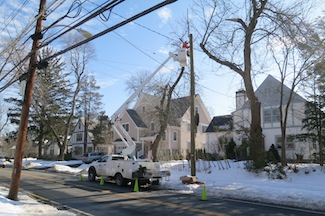 Though many residents were lobbying to fight Crown Castle's application to install a Distributed Antenna System (DAS) in Scarsdale, it looks now as if the Planning Board will work to preserve as much local control as possible but will not bar the carrier's entry to the Village.
Though many residents were lobbying to fight Crown Castle's application to install a Distributed Antenna System (DAS) in Scarsdale, it looks now as if the Planning Board will work to preserve as much local control as possible but will not bar the carrier's entry to the Village.
The Planning Board held a work session at Village Hall on 4/11 to review information from an attorney and an engineer and to get feedback from concerned residents.
As a result of the NextG (now Crown Castle) application to set up 15 nodes in Scarsdale, the Planning 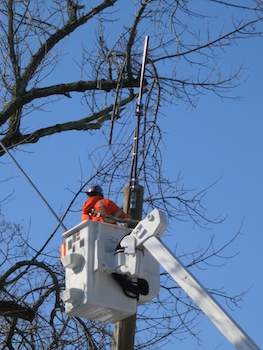 Board retained the services of telecommunications law expert Joseph Van Eaton of Best, Best and Krieger and Lee Afflerbach of the engineering firm CTC Technology and Energy. Both have advised other municipalities who installed DAS systems.
Board retained the services of telecommunications law expert Joseph Van Eaton of Best, Best and Krieger and Lee Afflerbach of the engineering firm CTC Technology and Energy. Both have advised other municipalities who installed DAS systems.
Both experts concurred that DAS is here to stay in that it fills gaps in voice coverage, precludes the need for more large antennas, and allows for better delivery of broadband. Their advice appeared to be to draft laws that balance the rights of residents while heading off a legal challenge from Crown Castle.
In a similar fight in Greenburgh, the Greenburgh Town Board rejected Next G's proposal to install 20 antennas in residential areas only to be sued in federal court by the telecommunications company. Last July, in an effort to "preserve suburban character, aesthetics and property values," the Town Board turned down the NextG application. They concluded that NextG has failed to prove that its cell phone antennas was "needed to provide coverage to an area of unincorporated Greenburgh that currently has inadequate coverage." They also questioned the size requirements for the equipment and said it did "not meet the standard of minimal intrusiveness." They argued, "Did Next G prove that its facility "is the minimum height necessary to provide the coverage? We think not!"
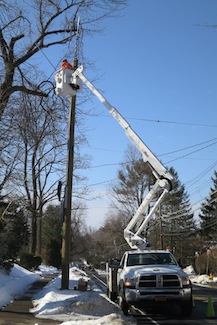 However it didn't end there. In August, 2012 the telecommunications company Crown Castle (under the name NextG Networks) filed a suit against the Town of Greenburgh, accusing town officials of creating roadblocks during the application process, keeping the company from installing their antennas and providing its services. Their lawsuit charges that the Town unreasonably delayed the company's application, which they filed in November of 2009.
However it didn't end there. In August, 2012 the telecommunications company Crown Castle (under the name NextG Networks) filed a suit against the Town of Greenburgh, accusing town officials of creating roadblocks during the application process, keeping the company from installing their antennas and providing its services. Their lawsuit charges that the Town unreasonably delayed the company's application, which they filed in November of 2009.
Therefore, in his presentation to the Scarsdale Planning Board on 4/11, Van Eaton briefed the group on the law and highlighted issues to consider when revising our zoning code, which now requires that the antennas be a minimum of 350 feet from a residence.
He explained that federal law mandates the following:
- Removals of barriers to entry that prohibit telecommunications companies from providing service
- Non-discriminatory treatment of one carrier over another
- Local control of land use-- however, siting decisions regarding personal wireless service facilities must meet federal standards. i.e. is service necessary to close a significant gap in service?
- A local government may not deny any eligible facilities request for a modification of an existing wireless tower or base station that does not substantially change the physical dimensions of such tower or base station
- Localities cannot make zoning decisions based on concerns about the health hazards of radio frequency (RF) as long as the FCC allows it
- Localities must act on an application within a reasonable period of time
Eaton suggested that the Planning Board consider whether the system is necessary, whether it would fill gaps in service and if it could be located in other places then on utility poles in the Village right of way. He also suggested the Board determine if Crown Castle could place their antennas on existing towers.
gaps in service and if it could be located in other places then on utility poles in the Village right of way. He also suggested the Board determine if Crown Castle could place their antennas on existing towers.
He ended by leaving the Planning Board with the following recommendations:
- Make policy choices with federal law in mind, but also considering how to preserve community property values, and protect the public interest.
- Maintain and revise local ordinances in light of federal requirements, and in light of possibility that new regulations will be developed from time to time
- Protect local values is possible; conflict can be avoided if DAS providers are willing to work with community
And also posed the following questions:
- Does the Village want to share its light poles?
- Does the Village allow ancillary equipment above ground (does it matter if the area is residential)?
- Is it better to have a lot of small antennas or a few larger antennas?
- If the Village allows any single user on its proprietary property, will it be required to lease to others and allow collocation?
- If the Village allows DAS on ground that it is unintrusive, how will collocation be addressed? What if multiple providers wish to build?
- How do you address community concerns about RF?
See a presentation from Van Eaton here:
Afflerbach then made his presentation to the group, explaining the DAS is a series of antennas placed in a strategic location and connected to a central system. In most cases they are connected to existing poles or structures in the right of way and allow for better cell coverage of challenging terrains. In his view, the large cell towers are going to fill up quickly, and DAS offers the best way to improve service.
He suggested that the Village look at other structures as possible sites for DAS antennas and did a survey of the Village. Rather than place the antennas on existing utility poles, Afflerbach came up wit the following alternative locations:
- Village incinerator smoke stack on Secor Road
- The top of Freightway Garage
- The church cupola at 1 Heathcote Road
- The communications tower at the Public Safety Building on the Post Road
- The cell tower on the Hutchinson River Parkway
- The train stations and the pipeline
Since the technology is changing rapidly he also advised the Board to grant short term licenses to the telecommunications companies so that the Board could reconsider their options every few years in light of new developments. Read the full report here:
About 15 residents were on hand to pose questions and make requests:
Marjorie Rosenblatt wanted to know what could be done to prevent more companies for making applications and crowding our streets with wires and equipment. Deb Pekarek asked if the equipment could be installed underground rather than wired onto poles. Carrie Fishman asked whether the water tower on Garden Road could be used to hold an antenna.
David Polsky told the Board to consider the rights of residents on smaller lots where the placement of an antenna could be as little as 10 feet from their windows. Natasha Rose of Ridgecrest East where Crown Castle has proposed to site one of the antennas said, "How are we discriminating against Crown Castle if we say no to everyone?" Jim Rose of Ridgecrest East said that he could already see the communications tower at the Public Safety Building from his back window and now feared he would see a DAS antenna out of his front window. He asked the Planning Board to consider provisions to mandate a minimum distance between towers to prevent one home from being unfairly impacted.
Jeff Berman asked about potential revenues from the antennas and was told that Crown Castle could rent these locations out to three carriers who would pay $100,000 per year per location. He suggested the Village build these ourselves. He also asked how much Scarsdale would receive from the installation of the DAS antennas and the answer was nothing. Wendy Lee asked the Board to consider property values, saying, "Are you going to buy a house with a DAS system outside?"
Rosenblatt spoke again, saying, "If we took a poll and found out that no one was going to sign up, would that put an end to it?" Jim Carforo said, "What's the downside of placing the antennas in a vault underground?" He also asked the Board to make the first draft of the proposed code public so that residents would have the chance to review it.
Planning Board Chairman Jane Veron ended the session by stating the Board's next steps will be to outline different policy options that would maximize Scarsdale's regulatory authority and to examine what other municipalities are doing.
No timetable was given for the next meeting.
Residents filed out of the meeting with a deep sense of irony about the issue:
- None of the residents in the room felt they needed better cell service
- No one wanted additional equipment placed on already strained utility poles
- Some feared cancer risks from radio frequency emissions near their homes
- Others worried about property value losses in DAS locations
- The Village would not realize any financial gain from allowing the installation
Yet with a sense of helplessness they acknowledged that a Federal statute prevents the Planning Board and ultimately the Board of Trustees from denying Crown Castle access to the village. Puzzling indeed.
Here is a list of the locations of the 15 nodes originally proposed in Scarsdale:
- 181 Fox Meadow Road
- 1 Ogden Road
- 21 Autenrieth Road
- 149 Lee Road
- 252 Grand Boulevard
- 28 Heathcote Road
- 17 Heathcote Road
- 12 Ross Road
- 54 Claremont Road
- 12 Ridgecrest East
- 7 Sycamore Road
- 11 Wynmor Road
- 109 Mamaroneck Road
- 4 Drake Road
- 81 Brookby Road
Addendum: Just two days later, without any notification to residents, a DAS antenna was installed on Palmer Avenue, directly in front of a house at 60 Palmer. The owner had not been notified, and according to a witness the man was surprised and dismayed.
Calls to the Village revealed that Palmer Avenue is a state road and therefore NYS owns the right of way. Even though local zoning code precludes the installation of an antenna less than 350 feet from a residence, state law permits the installation and supersedes local law. Do residents have the right to notification and does the Village have any recourse?
We called Village Planner Elizabeth Marrinan and Village Attorney Wayne Essanason with our questions and the Village is going to verify who installed the antenna and look into what, if anything, can be done. The Village also believes that more antennas were installed on the Post Road and will investigate those as well. Here are pictures of the installation on Palmer Avenue courtesy of Jon Thaler.
Planning Board Meets Tonight to Discuss Zoning Code and DAS (Distributed Antenna Systems)
- Details
- Hits: 4393
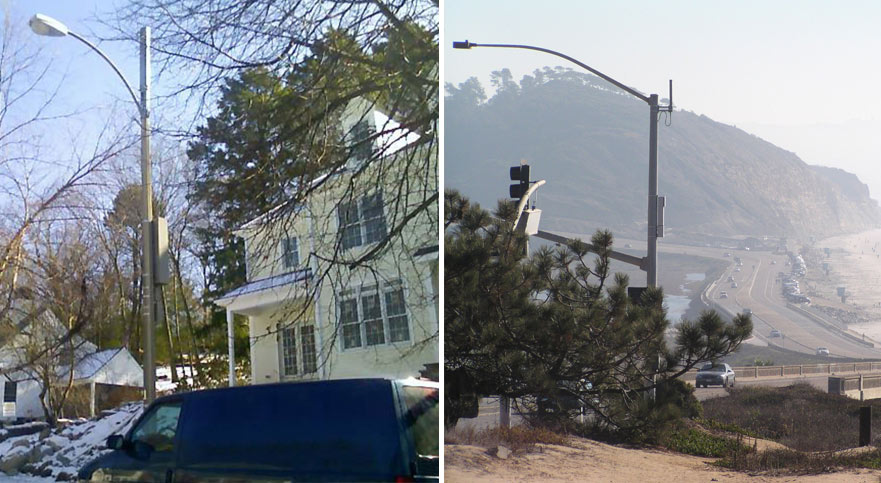 Concerned about the installation of DAS antennas on telephone poles near your house? Tonight (2-11) at 8 pm, the Planning Board of the Village of Scarsdale will hold a work session in the third floor meeting room of Village Hall to discuss the referral from the Village Board of a potential amendment to the zoning ordinance relative to the installation of Distributed Antenna Systems (DAS) technology in the public right of way. The Planning Board previously requested an engineering report from Columbia Telecommunications Corp to examine whether or not existing facilities could accomodate the needs of the wireless carrier as opposed to a DAS installation. By law, if the Board finds that there is not a "significant gap" in service, the Village would not be required to amend the code to permit the carrier to install additional equipment.
Concerned about the installation of DAS antennas on telephone poles near your house? Tonight (2-11) at 8 pm, the Planning Board of the Village of Scarsdale will hold a work session in the third floor meeting room of Village Hall to discuss the referral from the Village Board of a potential amendment to the zoning ordinance relative to the installation of Distributed Antenna Systems (DAS) technology in the public right of way. The Planning Board previously requested an engineering report from Columbia Telecommunications Corp to examine whether or not existing facilities could accomodate the needs of the wireless carrier as opposed to a DAS installation. By law, if the Board finds that there is not a "significant gap" in service, the Village would not be required to amend the code to permit the carrier to install additional equipment.
Telecommunications company NextG has applied to put up 15 antennas in Scarsdale – which they can then rent out to up to three cell-phone companies in order to improve their service in this area. In order for these to be installed, Scarsdale would need to amend its current zoning code that mandates that a cell phone antenna cannot be within 350 feet of a residential structure. Since Next G considers itself a utility, they argue that they should have the right to place their equipment in the Village right of way, similar to Con Edison, Verizon or Optimum. If the Village refuses to change the zoning code to accommodate Next G they could face legal challenges for blocking telecommunications expansion on a discriminatory basis.
Read more about this issue here and attend the meeting at Village Hall tonight to see where the Planning Board stands on modifications to the zoning code.
Nemo Could Blanket Scarsdale with 18" of Snow
- Details
- Hits: 3630
 It could be another big one! The Village is warning residents to expect 12-18 inches of snow by tomorrow, February 9. All I can say is I hope the wind does not kick up. Many of us have still not made repairs to the damage caused by Hurricane Sandy – so another storm is not welcome here! And I don't know about you, but we have already worn out our welcome at our friends with generators.
It could be another big one! The Village is warning residents to expect 12-18 inches of snow by tomorrow, February 9. All I can say is I hope the wind does not kick up. Many of us have still not made repairs to the damage caused by Hurricane Sandy – so another storm is not welcome here! And I don't know about you, but we have already worn out our welcome at our friends with generators.
The weather service has named this tempest Winter Storm Nemo, but forecasters warn there's nothing cute about it.
Be prepared: stock your refrigerator and get out your candles. Anyone who has a car parked on the street should move it now as the Village wants all streets cleared so that snow can be plowed.
If you have storm related news, or photos, share them with Scarsdale10583 readers. Either email us at [email protected] or post comments below.
Here's the notice we just received from Scarsdale Village:
The Village Administration has been monitoring the weather reports and preparing for the forecasted snow storm accordingly. It is likely by Saturday morning 12-18 inches may have accumulated in the Village. Snow removal efforts by the Village Department of Public Works will continue through the weekend until all the roads are cleared. Calling to report road conditions is not necessary; however, please call the Police Department at 722-1200 to report any downed trees or power lines. In addition, if power outages occur, please call Con Edison immediately to report your outage in order to get your electricity restoration in the cue. The Con Ed Customer Service number is 1-800-752-6633 (1-800-75-CON ED)
Private property Snow Removal:
Please remind your snow removal contractors to be mindful when plowing driveways and not leave snow on the public roadways. It is best, whenever possible, to shovel/plow the snow onto lawns and adjacent property, never into the street. The Village snow plows are working quickly and cannot avoid plowing the snow back across the 5,300 driveways in the Village, so if snow is plowed back across your driveway(s) please shovel it back out to the sides of your driveway, not into the street.
Parking
Residents may park their vehicles in the Freightway Garage from 3pm today and must be removed by midnight Sunday.
There are no other changes in the parking regulations. Overnight parking is prohibited on all streets in the Village. If at all possible please do not park on the street during the snowfall. Vehicles parked on the street prolong the snow removal process.










